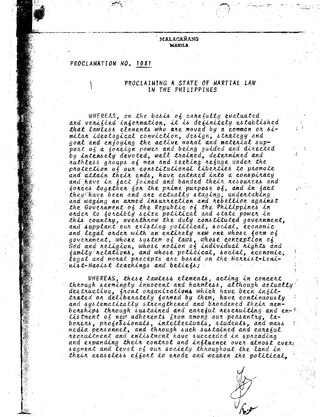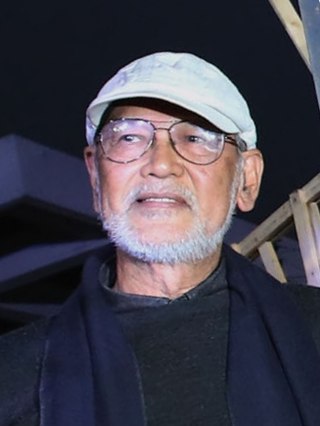
Tarlac, officially the Province of Tarlac, is a landlocked province in the Philippines located in the Central Luzon region. Its capital is the city of Tarlac, which is the most populous in the province. It is bounded on the north by the province of Pangasinan, Nueva Ecija on the east, Zambales on the west, and Pampanga in the south. The province comprises three congressional districts and is subdivided into 17 municipalities and one city, Tarlac City, which is the provincial capital.

Aldo Renato Guttuso was an Italian painter and politician. He is considered to be among the most important Italian artists of the 20th century and is among the key figures of Italian expressionism. His art is characterized by social and political commentary, and as a member of the Italian Communist Party (PCI) he became its senator for two legislatures, from 1976 to 1983, during Enrico Berlinguer's secretariat.

Proclamation No. 1081 was the document which contained formal proclamation of martial law in the Philippines by President Ferdinand Marcos, as announced to the public on September 23, 1972.
Santiago Bose, also known as Santi Bose, was a mixed-media artist and community organizer from the Philippines who co-founded the Baguio Arts Guild. He is recognized by the Cultural Center of the Philippines as a pioneer in the use of indigenous materials.

Pablo Cueto Amorsolo was a Filipino painter. He was the younger brother of the Philippine National Artist Fernando Amorsolo.

Benedicto Reyes Cabrera, better known as "BenCab", is a Filipino painter who was conferred a National Artist of the Philippines for Visual Arts (Painting) in 2006. He has been noted as "arguably the best-selling painter of his generation of Filipino artists."

The Bantayog ng mga Bayani, sometimes simply referred to as the Bantayog, is a monument, museum, and historical research center in Quezon City, Philippines, which honors the martyrs and heroes of the struggle against the dictatorship of the 10th Filipino president Ferdinand Marcos.
Imelda Cajipe-Endaya is a Filipino visual artist, curator, author, activist, and community leader. She is known for her printmaking, painting, mixed-media art, and installation art. She is also an author of various texts and books, as well as the co-founder of Kasibulan, an artist collective in the Philippines. She also initiated the Pananaw, of which she was the first editor. Cajipe-Endaya has become a main figure Filipino feminist and national liberation movements and Philippine art. Her advocacy of women centers around Philippine history and culture.
Kiri Dalena is a visual artist, filmmaker and human rights activist who lives and works in the Philippines. Her work deals with issues of political and social injustice, drawing from events in Philippine history.
Jose "Joe" Pacturayan Dizon was a Filipino priest and activist who fought against the dictatorship of then President Ferdinand Marcos.

Benjamín Roberto "Behn" Holcombe Cervantes was a Filipino artist and activist. He was highly regarded as a theater pioneer, teacher, and progressive thinker who was detained multiple times during martial law in the Philippines.

Roberto Salas Benedicto was a Filipino lawyer, ambassador, diplomat, and banker historically most remembered as a crony of President Ferdinand Marcos. Benedicto owned Philippine Exchange Company, the Philippines Daily Express, Radio Philippines Network (RPN), Banahaw Broadcasting Corporation (BBC) and Intercontinental Broadcasting Corporation (IBC). Benedicto was the Philippines' ambassador to Japan from 1972 to 1978.
During the administration of former Philippine president Ferdinand Marcos (1965–1986) select businesses were favored and patronized by Marcos, receiving financial support, sole patronage, tax exemptions, and control over entire industries rendering these businesses as monopolies. Friends and relatives of Marcos acquired staggering wealth and economic power due to special favors and privileges extended by the administration. While Marcos associates enjoyed government bailout even during the decline of their firms, other businesses suffered high taxes, sanctions, and other unjust treatments that forced them to close up, or to sell their shares. The majority of monopolies linked to Ferdinand Marcos are managed by his close associates, also regarded as cronies by critics. Former First Lady Imelda Marcos insinuated that the Marcoses controlled the majority of the industries in the Philippines. In a 1988 interview, she stated, "We practically own everything in the Philippines—from electricity, telecommunications, airline, banking, beer and tobacco, newspaper publishing, television stations, shipping, oil and mining, hotels and beach resorts, down to coconut milling, small farms, real estate and insurance."

During the presidency of Ferdinand Marcos, Filipino workers in the labor industry experienced the effects of government corruption, crony capitalism, and cheap labor for foreign transnational industries, One of the objectives of Martial Law was to cheapen labor costs, in order to attract transnational corporations to export labor to the Philippines. Marcos signed many presidential decrees beneficial only to his associates, while allowing for the forced relocation of indigenous peoples, decreasing workers' wages, and murders of labor activists. Minimum wage was a fixed PHP8.00 per day. Many workers were unemployed or underemployed. It was also during the Marcos presidency when the practice of contractualization began, enabling managements to avoid giving regular, permanent status to employees after six months of work. Strikes were banned and the government controlled trade unions, leaving workers without effective protection against employers who had unfair labor practices and regulations.
Edgar "Egai" Talusan Fernandez was a Filipino socialist-realist painter. His art style was noted for portraying the Philippines as "a multi-ethnic country that is still embroiled in social issues such as civil conflicts." Active in the Philippine art scene from the 1970s onwards, he was particularly known for his activist art which criticized the dictatorship of former Philippine President Ferdinand Marcos.

Armando "Mandrake" Ducusin Palabay was a Filipino student leader and activist from San Fernando, La Union. He is best known for his work in organizing anti-Marcos campaigns during the first quarter storm and the early days of Martial law under Ferdinand Marcos. He was killed for the anti-Marcos cause while doing community work among the indigenous Tingguian people of Sallapadan, Abra, in 1974, and was honored in 2001 by having his name inscribed on the Wall of the Remembrance at the Philippines' Bantayog ng mga Bayani, which honors the martyrs and heroes who fought the dictatorship.
Alice G. Guillermo was a Filipino art historian, critic, academic, and author.

The La Tondeña strike was a protest action that happened in October 1975, notable for being the first major strike to be held after Ferdinand Marcos' 1972 declaration of martial law in the Philippines. It is also considered as one of the first major open acts of resistance against the Marcos dictatorship and an important turning point for the period.
Journalism during the Marcos dictatorship in the Philippines—a fourteen year period between the declaration of Martial Law in September 1972 until the People Power Revolution in February 1986—was heavily restricted under the dictatorial rule of President Ferdinand Marcos in order to suppress political opposition and prevent criticism of his administration.
The Negros famine took place on Negros island in the Philippines in the mid-1980s, during the waning days of the Marcos dictatorship. It was a key moment in the history of sugar production in the Philippines, as well as the broader political history of the Philippines. Caused by the Marcos administration's efforts to control sugar production through the NASUTRA monopoly held by Marcos crony Roberto Benedicto and by a sudden crash in international sugar prices, it created what popularly came to be known as a "social volcano", with tensions culminating in the Escalante massacre, and with negative effects still felt even after the ouster of Ferdinand Marcos and his cronies during the 1986 People Power Revolution.












